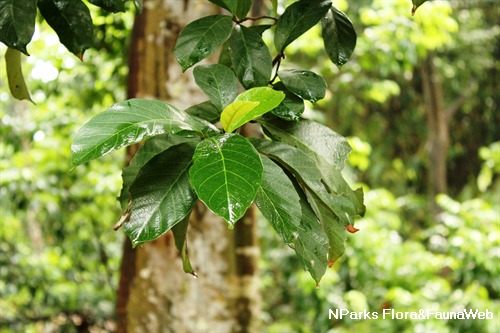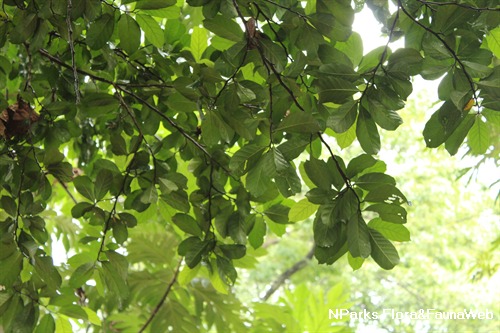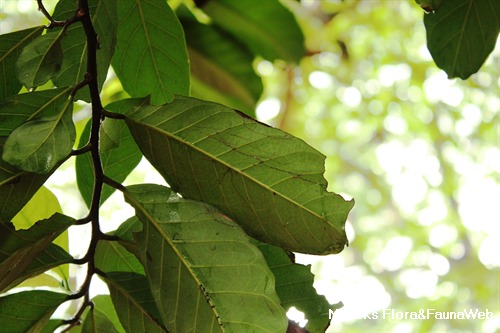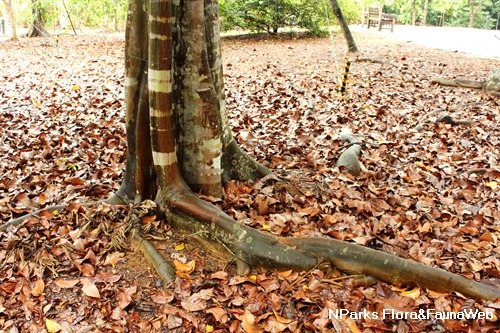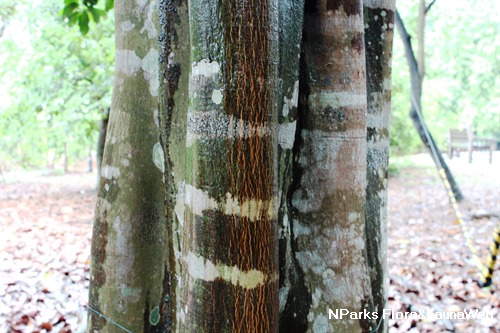
Back
Treculia africana Decne.
| Family Name: | Moraceae |
| Synonyms: | Artocarpus africana Sim., Treculia centralis A.Chev. |
| Common Name: | African Breadfruit, Ukwa Seed |
Name
Classifications and Characteristics
| Plant Division | Angiosperms (Flowering Seed Plants) (Dicotyledon) |
|---|---|
| Plant Growth Form | Tree (Medium (16m-30m)) |
| Lifespan (in Singapore) | Perennial |
| Mode of Nutrition | Autotrophic |
Biogeography
| Native Distribution | Tropical Africa |
|---|---|
| Native Habitat | Terrestrial |
| Preferred Climate Zone | Tropical |
Description and Ethnobotany
| Growth Form | A medium sized tree usually grows up to 30 m tall, with some up to 50 m tall. |
|---|---|
| Crown | The crown is dense and spreading. |
| Trunk | Trunk is fluted, up to 3 m in girth. Bark is grey and smooth, exuding white latex which later changes to rusty red when cut. |
| Foliage | The alternately arranged leaves are simple, ovate with pointed tips, measuring 30-50 cm long and 14-20 cm wide. Upperside of the leaf (adaxial surface) is dark-green and smooth, while underside (abaxial surface) is paler and hairy. Both the main vein and the 10-18 pairs of side veins are prominent. Leaf petioles are short, about 1.5 cm in length. Young flushes are red or yellow in color. |
| Flowers | Flowers are green in color, with male ones borne in leaf axils and female ones on main branches, 2.5-10 cm in diameter. |
| Fruit | Fruits are greenish-yellow when mature, round, very large, up to 30 cm in diameter and 8-14 kg in weight, rough surface. Fruit pulp is spongy with many seeds measuring about 1 cm in length. There are 150-500 seeds per fruit. |
| Habitat | Swampy areas or along rivers in tropical forests, up to 1,200 m altitude. |
| Etymology | Treculia is named after Auguste Trecul, a Fench botanist in 19th century. |
| Ethnobotanical Uses | Edible Plant Parts : Edible Fruits, Edible Leaves, Edible Seeds Food (Fruit or Vegetable): Seeds are ground into breadfruit flour to make baked foods. The powered seeds are also made into drinks. Seeds can also be consumed dried, fried or roasted. Medicinal: The bark decoction is used in the treatment of cough, while the root decoction is used as anthelmintic and febrifuge. Timber & Products: The wood is heavy and has an even structure, suitable for furniture and carving. It is also suitable to make firewood and charcoal. Agriculture - Forestry: The leaves and fruit pulp are used as fodder. |
Landscaping Features
| Desirable Plant Features | Ornamental Fruits |
|---|---|
| Landscape Uses | General, Parks & Gardens, Riverine, Shade Providing Tree / Palm |
| Thematic Landscaping | Economic Garden |
Fauna, Pollination and Dispersal
| Seed or Spore Dispersal | Biotic (Fauna) |
|---|
Plant Care and Propagation
| Light Preference | Full Sun, Semi-Shade |
|---|---|
| Water Preference | Moderate Water |
| Rootzone Tolerance | Moist Soils, Well-Drained Soils, Fertile Loamy Soils |
| Propagation Method | Seed, Stem Cutting, Grafting |
Foliar
| Foliage Retention | Evergreen |
|---|---|
| Mature Foliage Colour(s) | Green |
| Prominent Young Flush Colour(s) | Red, Yellow / Golden |
| Foliar Type | Simple / Unifoliate |
Floral (Angiosperm)
| Flower Colour(s) | Green - Light Green |
|---|
Fruit, Seed and Spore
| Mature Fruit Colour(s) | Yellow / Golden, Green - Light Green |
|---|---|
| Mature Fruit Texture(s) | Rough |
| Mature Seed Colour(s) | Brown |
| Seed Quantity Per Fruit | Numerous (>20) |
Image Repository
Others
| Master ID | 30473 |
|---|---|
| Species ID | 4782 |
| Flora Disclaimer | The information in this website has been compiled from reliable sources, such as reference works on medicinal plants. It is not a substitute for medical advice or treatment and NParks does not purport to provide any medical advice. Readers should always consult his/her physician before using or consuming a plant for medicinal purposes. |

